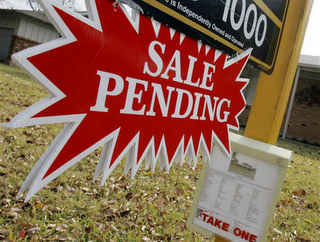The National Association of REALTORS® Pending Home Sales Index rose for the third straight month last month. What does it mean for you?
A rising pending homes sales index means there a lot of buyers in the market. With fewer homes being built, and a growing population, this means greater demand Greater demand means higher home prices due to more competition! 
If asking the seller for closing costs, you may find it more difficult to get an offer accepted……that’s why you should consider a closing or down payment assistance program to help get your offer accepted.
A “pending home sale” is a home under contract to sell, but not yet closed.
The Pending Home Sales Index rose 5 percent in March, posting its second-highest reading since April 2010. Not coincidentally, that month marked the expiration of last year’s federal home buyer tax credit.
Home buyers and sellers in the Inland Empire’s Riverside and San Bernardino county would do well to watch the Pending Home Sales Index each month. This is because — unlike most government and private data — the Pending Home Sales Index is a “forward-looking” indicator.
Because 80% of “pending” homes close within 2 months, and a significant share of the rest close within months 3 and 4, the Pending Home Sales Index tends to correlate to future strength (or weakness) in housing.
The Pending Home Sales Index, in other words, is an excellent precursor to the Existing Home Sales report, issued monthly.
By region, the Pending Home Sales Index varied last month.
- Northeast : -3.2% from February
- Southeast : +10.3% from February
- Midwest : +3.0% from February
- West : +3.1% from February
All 4 regions were worse from a year ago….but it’s rising again.
As with everything in housing, we must remember that real estate is neither national, nor regional. It’s local. Sales volume may be higher in areas like the Midwest, but that doesn’t mean that all Midwest markets are experiencing similar gains, if any gains at all.
To get local real estate data for Temecula/Murrieta/Menifee, the Corona/Riverside/Moreno Valley, or the San Bernardino/Rancho Cucamonga areas, talk to a real estate agent that specializes in that area. It’s the best way to know what’s happening on the street level.
If you want a referral of an agent I think is one of the best too work with in an area you are interested in buying, give me a call or shoot me an email brad(at)homeloanartist(dot)com.

Well, yes, it IS a seller’s market if you are a bank. However, here in northern California, most communities are heavily impacted by the continuing presence of bank-owned homes. Until we move this bank-owned REO inventory back into the hands of real homeowners, it is difficult to expect the kind of price appreciation you would find in a traditional “Seller’s Market”.
Thank God for FHA low-down financing. This is the new homeowners savior!
Bob, good point, this is not a traditional sellers market.
We’ve been in this non-traditional sellers market for so long now that it seems to be the norm…..or becoming the traditional market. I think only 10% of all homes listed in my area are regular sales……and by regular, I mean where a real person living in the home is selling. Not where an investor purchased the home as a short sale or bank REO and then turns and flips it. I’m not sure why those are considered regular or standard sales.
I am closing a $260,000 sale this week for a wonderful family relocating into Temecula! Finally. We wrote 5 offers before being able to obtain this one. I pride myself on writing very clean contracts but every home had multiple offers.
I feel that it’s relative to price range in our local market. Homes under $ 400,000 if priced correctly are sold very quickly.
Great post!
That’s great April! It takes an experienced agent to get a buyers offer accepted in a busy market like Temecula where multiple offers is the norm. I know listing agents and sellers appreciate a well written offer/contract and probably toss out the offers that are missing all kinds of info they require.